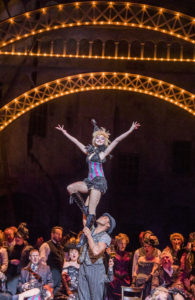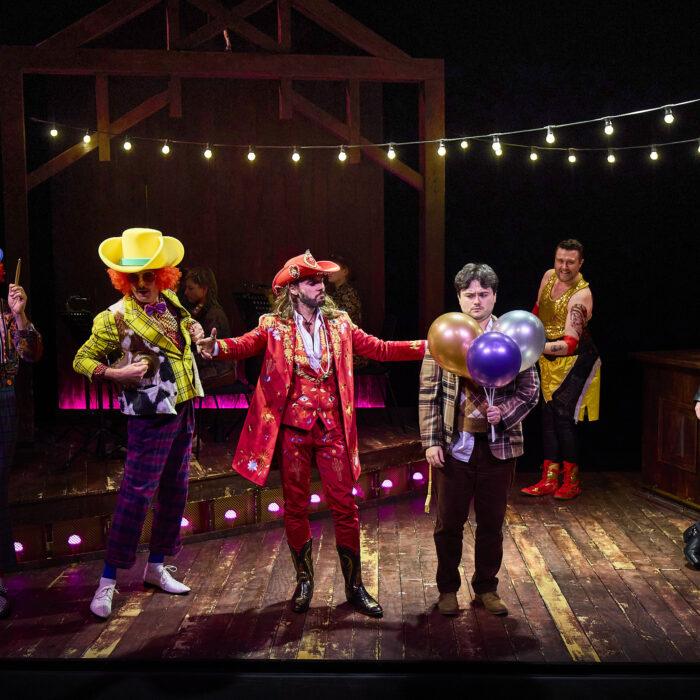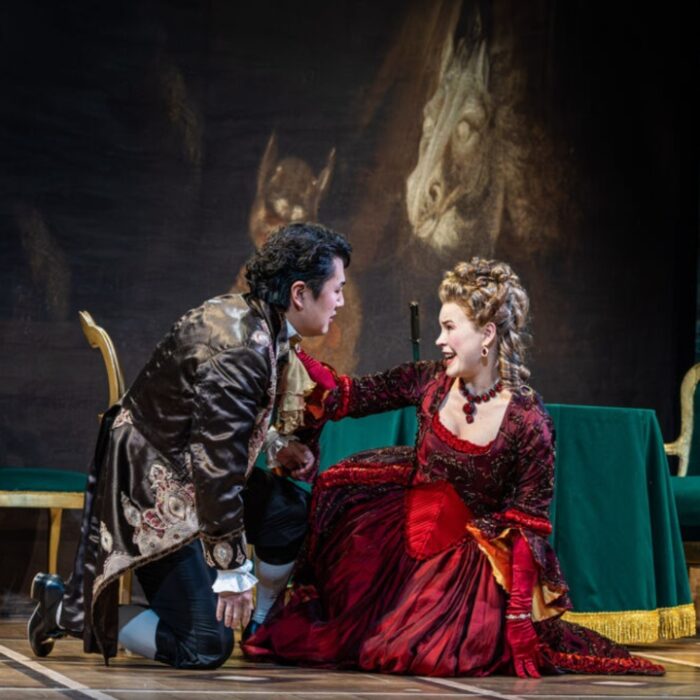
Royal Opera House 2018-19 Season Review: Faust
Led By Michael Fabiano & Erwin Schrott, This Disheveled Revival Conjures No Sympathy for Its Devils
By Sophia LambtonA Gothic fairy tale, the “Faust”s of Goethe and Gounod are both ahead of their time as morality plays – duplicitously tempting their readers and spectators with the very hedonism they purport to chastise. At the end of Act three, Méphistophélès crassly laughs over the end of Faust and Marguerite’s tender duet. The contrast between bewitching, shimmering violins exuding ripening love with their tenuous tremolos and the crude sound of his roaring guffaw is deliberately jarring; innovative in a Hitchcockian way for an 1859 opera.
Elegance Disorganized
Extracting the eeriest episodes from the libretto in the interest of ominous staging could make for an elegant, clear-cut vision. David McVicar’s original 2004 production followed a well-conceived template of designs meant to showcase the debauchery, lasciviousness and hypocrisy of the Belle-Époque France of Gounod’s later years. Its color palette – the grisly, soot-smeared stone apartment blocks that echo the visuals of naturalism and works of Zola, together with the scarlet velvet curtains and red lightbulbs reminiscent of the Moulin Rouge’s first years in service, interlock elegantly.
Although the production has always suffered from a handful of excessively “on-the-nose,” moments – such as a pregnant ballerina imitating sinful Marguerite in its ballet, a dance inserted in the work 10 years after its premiere purely to ensure it fitted the conventions of “Grand Opera” tropes – it has never been guilty of clutter. Now in its fifth inception, revival director Bruno Ravella has clumsily plastered this sheen on the congruous gloss of the spectacle, casting over it a shadow of manifest disarray.
Chorus members, who perform very well vocally, are largely clueless as to where to move. Their presence is frequently obstructed by the now-ubiquitous band of bare-chested male dancers who appear in the majority of Royal Opera productions. Often clad in black leather regardless of any time setting, they perform modern dances so questionably choreographed that routines from movies like “Risky Business” and “Coyote Ugly”seem inventive in hindsight. With so much physically ado onstage, spectators’ eyes are at loss as to where they should wander.
Ailing Leads
On the musical side, things were similarly lacking in cohesion.
Michael Fabiano’s Faust – contrary to the intrinsic nature of the wanton anti-hero – seemed cautious throughout. Though he impressively layers the voice of old Faust with a deliberate wobble in the middle register, following his youthful reincarnation Fabiano seems far more reserved and somewhat cooler in his expression. In some instances his diction sounded more Italian than French with some vowels closed up a tad bit; this was present in his pronunciation of “pénetre” which sounded more like “pi-ne-tre.”
Throughout the aria that follows that word, the aforementioned beloved “Salut, demeure, chaste et pure,” Fabiano seemed unsteady in the upper register, at times growing an abrupt crescendo at the end of a phrase to compensate. Coming to the high C at the end of “pré-sen-ce,” his voice fell into the falsetto pit.
Despite an announcement that a throat infection plagued him, Erwin Schrott sustained the physical carriage of sadistic Méphistophélès, very clearly looming over this production as its most authentic character. Complimenting his movement, his instrument – with its uncrackable, cavernous volume – can manifestly tackle the role of the formidable devil. On this occasion, however, the knowledge of his illness got the better of him. He sustained most notes comfortably but elected anxiously to hasten the completion of others. As a result the celebrated “Le veau d’or” aria, whose tempo customarily challenges basses to race through its accelerated, intricate intervals, sounded too nervous to incorporate its much needed panache and the ceremony Schrott can undoubtedly bring to the role.
Substituting the ailing Irina Lungu, who was in turn substituting the previously announced Diana Damrau, soprano Mandy Fredrich performed the role of Marguerite with impressive technical accuracy. With the endearingly slender instrument of a swallow, her Marguerite easily came off as a naïve, girlish fledgling. Fredrich’s contemplative approach to the narration of the tale of the King of Thule, “Il était un roi de Thulé”, was a subtly intimate, morose admission of the character’s emotions.
Poignancy Characterized
She adjusted tempo and rhythm in the excited aria that follows, “Ah! Je ris de me voir si belle dans ce miroir…” without any hesitation. While there was some element of caution about her performance – she had reportedly flown in to London only a couple of hours before – she managed the ascending arpeggios with sweet, refined delicacy.
Stéphane Degout’s Valentin brought a sophisticated dignity to this undignified production. Instilling in his personage the stubbornly authoritative physique of a soldier, he also imparted characterization to the ends of his phrases in “Avant de quitter ces lieux,” making them crisp and militarily brusque. It was an intriguing approach to what is usually a more lyrical aria, but Degout simultaneously infuses the lines with a pathos the soldier would never make known.
Imparting a puerile urgency to the trouser role of Siébel, mezzo-soprano Marta Fontanals-Simmons had occasional trouble with distributing her breath wisely but filled a large part of her notes with great ardor and clean vocal potency. Endowed with the kind of voluminous mezzo that sits precisely at the halfway point between alto and soprano, her higher register is well-sustained most of the time; some scales and ornaments could be improved on. Overall, however, there was great potential in her voice and the personification she amply applied to it.
The orchestra, here under the baton of Dan Ettinger, features brass frequently blasting brusque collectives of disbanded notes. They find they’re not alone as a great deal of instruments fall out of place in their sections. The sounds evoked from strings were unclean chords, their coalescence overly linear and lacking in roundness. With rubato for the most part lacking, Ettinger’s selected rhythms confine chords into a set of rigid blocks made up of mezzo-forte sameness. The solo violin that underlines the tenor aria “Salut, demeure, chaste et pure” was out of sync with its singer, as were the groups of other instruments accompanying many a duet and aria.
Buried under a hodgepodge of new, poorly engineered choreography and outspoken disorder, the original McVicar production seems to yearn to be exhumed. People get nervous in loud throngs of crowds. Chaos begets chaos. It’s no wonder that the practice of wrapping up old concepts in an indecisive new packaging – one with unrelated additions of movements and spectacle that don’t gel with the backdrop – will plunge its performers into an unforeseen state of anxiety.


